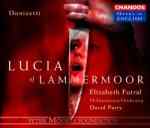Opera - Lucia of Lammermoor
GAETANO DONIZETTI
(1797-1848)
Lucia of Lammermoor
142:27
Tragic drama in three acts
Libretto by Salvatore Cammarano after Walter Scott's novel The Bride of Lammermoor
English translation by David Parry
Part One: The Parting
Scene 1 A garden at Ravenswood Castle
No. 1: Prelude and Introductory Chorus
2.
'Through the park and the woods that surround it'
2:03
Normanno, Chorus
Scene 2
No. 2 Scena and Cavatina
3.
'You seem unhappy'
2:55
Normanno, Enrico, Raimondo
4.
'Trembling, I feel the horror'
2:15
Enrico, Normanno, Raimondo
Scene 3
5.
'Your suspicions are confirmed now'
2:09
Chorus, Normanno, Enrico, Raimondo
6.
'All in vain do you try'
3:36
Enrico, Chorus, Raimondo
Scene 4 The Park
No. 3: Scena and Cavatina
8.
'He is not here yet! . . .'
1:47
9.
'In deepest night a silence reigned'
4:27
10.
'When, in the burning ecstasy'
4:52
Lucia, Alisa
No. 4: Scene and Duet
11.
'Here is Edgardo . . .'
2:52
Alisa, Edgardo, Lucia
12.
'Pray remember that my father'
3:18
13.
'Let us swear to love for ever'
2:23
Edgardo, Lucia
14.
'Imagine when the breezes sigh'
4:51
Lucia, Edgardo
Part Two, Act I: The Marriage Contract
Scene 1
No. 5: Scena
15.
'Lucia is coming to you soon'
3:13
Normanno, Enrico
Scene 2
No. 6: Duet
16.
'Come here to me, Lucia'
1:12
Enrico
17.
'In my eyes, as I approach you'
4:41
18.
'In secret I suffered the loneliness'
3:56
Lucia, Enrico
20.
'Your refusal will destroy me'
3:19
Enrico, Lucia
Scene 3
No. 7: Scena and Aria
Lucia, Raimondo
22.
'Ah! Listen, listen to friendly guidance'
2:17
23.
'In making such a sacrifice'
3:33
Raimondo, Lucia
1.
'We welcome you to celebrate'
3:40
2.
'Where is Lucia?'
1:44
3.
'Our mother's death still grieves her . . .'
2:13
4.
'What restrains me at such a moment?'
3:29
5.
'Wretched man, do as we tell you'
3:22
6.
'Go, you villain, detested and hated!'
2:21
7.
'Violent and cruel is the night'
2:18
9.
'I long for the moment when daylight is dawning'
2:45
10.
'So great the happiness that we are voicing'
1:46
11.
'Stop at once your celebrations' -
3:00
12.
'What you have told us is past believing!'
3:02
13.
'Oh God in heaven!'
3:16
14.
'Alas! I see the spectre between us'
3:59
15.
'They bring the incense'
6:33
16.
'Here is Enrico'
3:03
17.
'Scatter your tears of anguish'
4:40
18.
'My ancestors lie here buried'
4:13
19.
'A lonely grave will shelter me'
3:25
20.
'Such misfortune!'
4:13
21.
'Rest in peace, for I shall follow'
4:46
Solo: Elizabeth Futral soprano - Lucia
Solo: Paul Charles Clarke tenor - Edgardo
Solo: Christine Rice mezzo-soprano - Alisa
Solo: Stephen Chaundy tenor - Normanno
Choral: Geoffrey Mitchell Choir
Orchestra: Philharmonia Orchestra
Conductor: David Parry
















 My Wish List
My Wish List




